The Green Technology And Sustainability Market is estimated to be valued at USD 29.8 billion in 2025 and is projected to reach USD 225.0 billion by 2035, registering a compound annual growth rate (CAGR) of 22.4% over the forecast period.
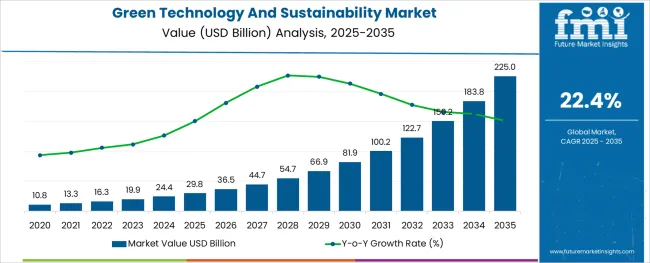
The green technology and sustainability market is gaining significant traction as organizations align business operations with environmental and regulatory goals. Rising climate change awareness, stringent carbon regulations, and global decarbonization efforts have driven enterprises to adopt clean technologies that enhance operational efficiency while minimizing environmental footprints.
Technological convergence especially the integration of AI, IoT, and blockchain has allowed real-time monitoring, predictive analytics, and traceability across energy, waste, and emission flows. Businesses are increasingly investing in sustainable innovation, driven by ESG compliance, stakeholder expectations, and energy cost optimization.
Strong government backing through green financing incentives, carbon offset initiatives, and climate tech subsidies has created a favorable landscape for scaling solutions. The market outlook remains positive, supported by expanding cleantech startups, digital sustainability platforms, and rising institutional commitments toward net-zero targets.
The market is segmented by Component, Technology, and Application and region. By Component, the market is divided into Solution and Services. In terms of Technology, the market is classified into AI and Analytics, Digital Twin, Cloud Computing, Blockchain, and Others. Based on Application, the market is segmented into Carbon Footprint Management, Green Building, Air and Water Pollution Monitoring, Weather Monitoring and Forecasting, Fire Detection, Crop Monitoring, Soil Condition/ Moisture Monitoring, Forest Monitoring, Sustainable Mining and Exploration, and Others. Regionally, the market is classified into North America, Latin America, Western Europe, Eastern Europe, Balkan & Baltic Countries, Russia & Belarus, Central Asia, East Asia, South Asia & Pacific, and the Middle East & Africa.
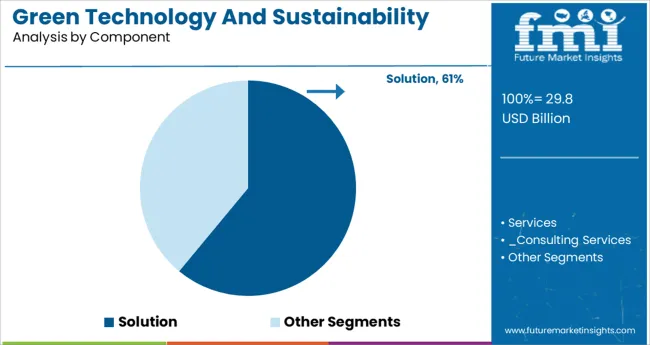
The solution segment is projected to account for 61.0% of total revenue in the green technology and sustainability market by 2025, positioning it as the leading component. This leadership is driven by widespread enterprise demand for integrated platforms that offer actionable sustainability metrics, energy optimization modules, and emission tracking frameworks.
Solutions enable holistic sustainability strategies, combining software-driven intelligence with automation tools to monitor, analyze, and mitigate environmental impacts. Their adaptability across various verticals—ranging from manufacturing and utilities to transportation and retail—has broadened adoption.
Additionally, increased digitalization in ESG reporting, driven by regulatory pressures and investor scrutiny, has further strengthened reliance on robust, scalable solution architectures.
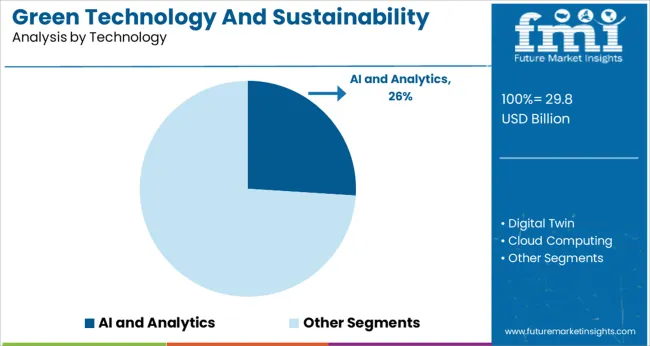
AI and analytics technologies are expected to hold 26.0% of the market share by 2025, establishing them as the dominant enabler within the green technology landscape. Their prominence is underpinned by capabilities that transform raw environmental data into predictive and prescriptive insights.
AI-driven platforms support automation in energy management, waste reduction, and climate risk modeling, helping organizations proactively mitigate operational inefficiencies. Analytics also plays a critical role in carbon credit modeling, supply chain transparency, and life-cycle assessments.
With regulatory authorities pushing for real-time compliance monitoring and sustainability disclosures, AI and analytics are becoming indispensable tools for both corporate strategy and public accountability.
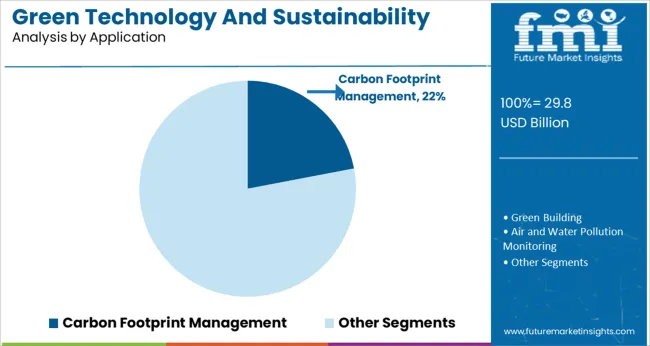
Carbon footprint management is expected to contribute 22.0% to total market revenue in 2025, making it the leading application area. This segment’s growth is being propelled by rising pressure on enterprises to quantify, disclose, and reduce greenhouse gas emissions across Scope 1, 2, and 3 categories.
Corporations are actively implementing digital tools to map carbon-intensive processes and set science-based targets aligned with global climate frameworks. Supportive policies such as carbon taxation, emissions trading schemes, and disclosure mandates under frameworks like the Task Force on Climate-Related Financial Disclosures (TCFD) have accelerated enterprise investments.
As supply chain decarbonization and energy transition emerge as board-level priorities, carbon footprint management is anticipated to remain a central pillar in sustainability transformation.
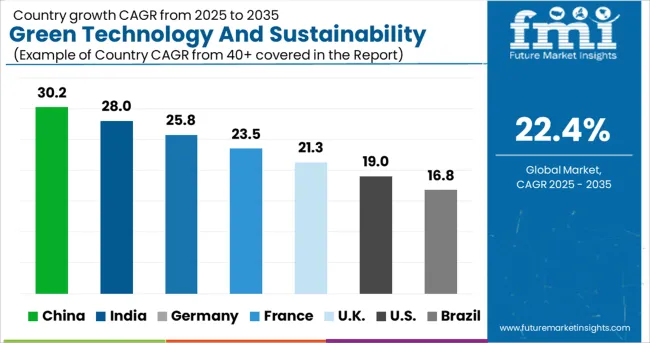
The United States is predicted to lead the green technology and sustainability market share during the projected period. The presence of renowned players is mostly responsible for the region's growth. Furthermore, prominent market players want to extend their worldwide footprint through business strategies such as cooperation, mergers, and partnerships.
Opportunity in Europe in Green Technology And Sustainability Market
Europe is predicted to have the world's second-largest market share. Leading government initiatives to demonstrate low-carbon technology innovation are projected to promote market growth. The European Commission (EU) proposes investing in market-ready innovations such as low-carbon and clean hydrogen solutions for energy-intensive industries such as chemicals, cement, and steel through its Innovation Fund.
Opportunity in Asia Pacific in Green Technology and Sustainability Market
The Asia Pacific market is expected to grow the fastest during the projection period. The primary economic participants in these developments are China, Japan, Taiwan, India, and South Korea. Governments in these nations have also made varied contributions to low-carbon, renewable development programs.
They have invested in developing new markets for renewable energy infrastructure manufacturing, such as solar and wind energy, smart grids, electric cars, and green buildings. These activities are intrinsically linked to the growth of overseas markets and prospective regional development in the export of clean technology items.
Green technology and sustainability solution providers focus on creating power supplies, integrated circuits, and devices that use less energy while also assisting customers in reducing their carbon footprint.
Competitors are preparing and making long-term commitments in a stable framework favorable to meeting everyone's requirements and developing ever more efficient and ecologically responsible solutions. They fulfill high environmental standards by producing low global warming potential solutions, following other environmental guidelines, and respecting their clients' energy consumption reduction demands.
Key players are dedicated to assisting the globe in meeting Sustainable Development Goals. They believe that the SDG framework will be one of the primary factors driving business over the next decade.
Manufacturers are delivering information sensing, transmission, and analysis technology for industrial growth markets. Aerospace and defense, industrial automation, air and water quality environmental monitoring, electronics design and development, oceanic research, energy, medical imaging, and pharmaceutical research are among these markets.
Organizations are increasingly adopting more sustainable business strategies because it is the ethical thing to do. This transition also provides financial and competitive advantages to businesses that prioritize environment and sustainability at all levels of the company. Market participants are assisting corporate leaders in incorporating sustainability into all they do, resulting in intelligent businesses that are sustainable at their core.
The development of green technology breakthroughs is primarily driven by an increase in energy usage and greenhouse gas (GHG) emissions. The focus on clean energy resources has grown as people are becoming more conscious of emissions from manufacturing industries like mining and forest monitoring.
Additionally, due to the widespread use of smart grid technology in a variety of industries, as well as its advantages in terms of cost effectiveness, dependable grid integration, and technological advancements in green technology, major leading businesses are increasingly choosing these solutions.
Global providers of green technology and sustainability market are introducing fresh business models and strategies in an effort to survive and grow their market share.
Numerous innovative approaches to help green initiatives, like more effective waste management, recycling, and RFID tag and sensor associations, are possible. An increase in the usage of RFID sensors, which reduce carbon emissions, as well as a surge in consumer and business interest in using renewable energy sources.
Green technology and sustainability market manufacturers are using nanotechnology to make products more efficiently, which further reduces waste.
The predicted high cost of green technology and sustainability solutions would likely restrain market expansion to some extent. Since solar and wind farms require little to no maintenance and no fuel, they are among the most cost-effective renewable energy sources.
As a result, the majority of the money is spent on developing technology-based products or solutions. The use of cutting-edge technology, such as AI, IoT sensors, and analytics, requires high maintenance costs in a number of applications, including air quality monitoring, carbon footprint management, and monitoring of air and water pollution.
During the forecast period, the solution segment is anticipated to represent a greater green technology and sustainability market share. The environment has been continuously exploited since the advent of globalization and innovation development.
New approaches toward green technology and sustainable development, which also take into account their social, economic, and environmental aspects, are made possible by emerging technologies.
During the projection period, the cloud computing technology category is anticipated to have the greatest green technology and sustainability market size. The advantages of the cloud in providing real-time remote access to data from satellite photos, sensors, and weather can be credited with this expansion.
As several firms are already embracing blockchain as a tool to make energy grids more accessible and sustainable by fostering data exchange in real time, blockchain has the potential to drive innovation in the field of green technology and sustainability.
According to FMI, during the projection period, the green building sector is anticipated to represent the largest green technology and sustainability market share. One of the major developments in the construction business nowadays is green building technologies. To monitor the residential state of building sectors, green building technology makes use of access card readers, RFID sensors and scanners, motion detectors, and other sensors.
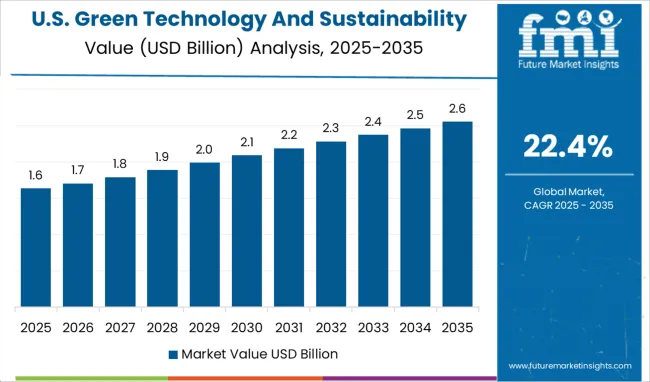
During the projection period, North America is anticipated to hold a dominant market share in green technology and sustainability.
The green technology and sustainability market in North America is expanding mostly as a result of the abundance of green technology and sustainability vendors there. To address the challenge of climate change and the rising levels of emissions, pollution, and waste, vendors are concentrating on R&D and the integration of cutting-edge technologies.
The second-largest green technology and sustainability market size in the global industry is anticipated to belong to Europe. Leading government programs showcasing cutting-edge low-carbon technology are anticipated to drive green technology and sustainability market expansion.
In order to promote a green recovery that would result in climate neutrality and relaunch the EU economy, the European Commission also planned to support energy storage, carbon capture and storage, and grid solutions. In numerous green technologies, including onshore and offshore wind power, European nations have become global leaders.
With the highest CAGR during the projected period, the Asia Pacific region is anticipated to be a market with excellent investment conditions. This development can be linked to developing nations' emphasis on the incorporation of cutting-edge technologies to improve commercial procedures, such as China, India, and Singapore.
During the forecast period, the Middle East & Africa and South America are anticipated to have a significant potential for growth. Governments have encouraged green energy sources as a component of their national climate policies.
New national, regional, and international organizations have been pioneered by Middle Eastern and South American nations, in an effort to create and sustain support for policies that reduce greenhouse gas emissions and promote renewable growth.
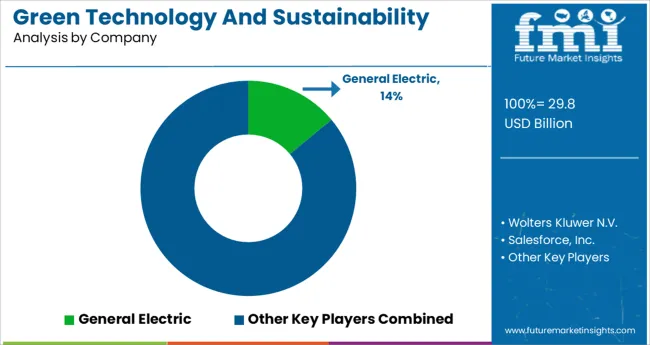
Presently, there are several market players that are becoming fiercely competitive in the green technology and sustainability market share. Few of the competitors are likely to capture the maximum portion of the green technology and sustainability market.
Recent Developments:
The global green technology and sustainability market is estimated to be valued at USD 29.8 billion in 2025.
It is projected to reach USD 225.0 billion by 2035.
The market is expected to grow at a 22.4% CAGR between 2025 and 2035.
The key product types are solution, services, _consulting services, _integration and technology services and _support and maintenance services.
ai and analytics segment is expected to dominate with a 26.0% industry share in 2025.






Full Research Suite comprises of:
Market outlook & trends analysis
Interviews & case studies
Strategic recommendations
Vendor profiles & capabilities analysis
5-year forecasts
8 regions and 60+ country-level data splits
Market segment data splits
12 months of continuous data updates
DELIVERED AS:
PDF EXCEL ONLINE
Green Ammonia Market Size and Share Forecast Outlook 2025 to 2035
Green Cement Market Size and Share Forecast Outlook 2025 to 2035
Green Power Market Size and Share Forecast Outlook 2025 to 2035
Green Chemicals Market Size and Share Forecast Outlook 2025 to 2035
Green Power Transformer Market Size and Share Forecast Outlook 2025 to 2035
Green Preservatives Market Size and Share Forecast Outlook 2025 to 2035
Green Tea Supplements Market Analysis - Size, Share, and Forecast 2025 to 2035
Green Data Center Market Size and Share Forecast Outlook 2025 to 2035
Green Logistics Market Size and Share Forecast Outlook 2025 to 2035
Green Methanol Market Size and Share Forecast Outlook 2025 to 2035
Greenwrap Market Analysis - Size, Share, and Forecast Outlook 2025 to 2035
Green Coatings Market Analysis by Technology, Application, and Region Forecast through 2035
Green Building Materials Market Analysis by Type, Application, End-user and Region: Forecast for 2025 and 2035
Green UPS Market - Trends & Forecast 2025 to 2035
Green Tire Market Growth – Trends & Forecast 2025 to 2035
Green Tea Extracts Market Analysis – Size, Share & Forecast 2025 to 2035
Green Banana Flour Market Analysis - Growth & Demand 2025 to 2035
Green Transformer Market Growth – Trends & Forecast 2025 to 2035
Green Electronics Manufacturing Market – Sustainability & Trends 2025 to 2035
Green Coffee Bean Extract Market Analysis by Form, Application, and Distribution Channel Through 2035

Thank you!
You will receive an email from our Business Development Manager. Please be sure to check your SPAM/JUNK folder too.
Chat With
MaRIA